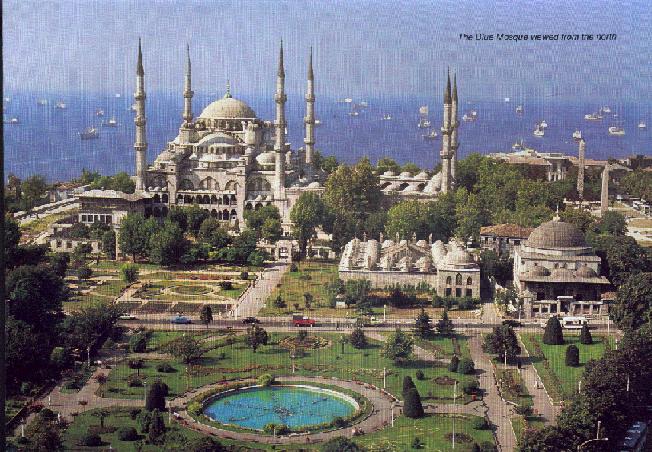|
|
|
(Sultan Ahmet Camii)
Gold or not, the mosque is one of the most beautiful buildings in the world and for most of the Ottoman period, state religious ceremonies and official declarations took place here.
The courtyard is paved entirely in marble slabs. Surrounding the main building are all the institutions traditionally included in the precincts: Madrassa - the seminary, poor-house, hospital, etc. This view is looking approximately north-east, across the Bosporus towards Üsküdar and Leander's Tower on the Asian side.
I have two other views of the Blue Mosque - this next one is taken from the roof area of the Hagia Sophia and looks south-west over the Sea of Marmara not quite in the direction of Büyükadar - Princes Island:

Here is my last view, this time from the inside of the mosque. The overriding blue motif which gives the mosque its nickname is clearly evident. A building of such rare beauty - even compared to Jerusalem's el-Aqsa and Khubat es-Sahra, that one feels overwhelmed to think that Man could create such an edifice as this. One point I will make and leave the rest unsaid: note just to the left of the Kibleh - the prayer direction facing south, towards Mecca, and ahead of us in this photograph - and just above the third set of double windows, the architectural feature with an appearance of stalactites dropping from the base of the apse (they can just about be picked out in the shadow). This feature was adopted by the Ottomans from their predecessors - the Mamelukes who left us many examples of this style in - among other places Jerusalem, a particularly good example of which can be seen at the exit from the Temple Mount via the Bab el-Qattnin - the Cotton Market Gate. This gate - together with the market itself was built in the 14th century by the Mameluke ruler of Damascus, Tankiz.

And if you would like a closer look at the stalactites:
